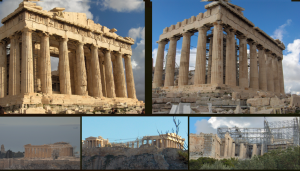Athens — Parthenon stabilization and restoration efforts continue
ø
Science and the Arts: Archaeological site preservation and art restoration.
Since first completed in 438 BC, the Parthenon atop the Athenian Acropolis has been the focus of multiple major archeological studies and engineering restoration projects. Over time, earthquakes, geologic weathering, and pollution have taken a toll. In addition, human damage, including a catastrophic explosion in 1687.

Parthenon The 1687 explosion during the Great Turkish War, resulted from Ottoman use of the Parthenon as gunpowder magazine. When the Venetian army, besieging Athens, fired a cannon shot that struck the Parthenon and caused a catastrophic explosion that decimated the central portion of the structure .
Much of the central structure and artwork withing was irreparably lost. The damage resulted in more than century of subsequent neglect and plundering.
The Parthenon suffered additional conflict-related damage during the Greek War of Independence/ Greek Revolution (1821-1830) when the Acropolis (which housed an Ottoman garrison) and the Parthenon were used as defensive positions by both the Ottomans and the Greeks at various times during the conflict. It was not until 1833, after the establishment of the independent Kingdom of Greece, that the Acropolis and Parthenon were finally returned to Greek control.
The 2006 restoration efforts, part of a larger effort started in the 1970s, centered on stabilizing structural instabilities. Efforts focused on areas especially vulnerable to seismic activity.
The 2006 efforts followed anastylosis restoration guidelines (the use of original architectural elements in rebuilding). New materials were only used when necessary and were made distinct to maintain historical integrity.
Those structural elements that were irreparably damaged and needed to be replaced often relied on Pentelic marble, the same type of marble used in the original construction.
The wires shown were installed to strengthen the Parthenon’s structural integrity against collapse, reduce leaning, and the enhance the solidity of its foundation.
Conservation efforts also continued on sculptures and friezes, with careful replication of original sculptures previously moved to the British Museum and the Louvre, were replicated using careful techniques to maintain the original design.
Photo: Ongoing stabilization and restoration efforts for the Parthenon and Acropolis. Athens, Greece. 2006. © K. Lee Lerner / LMG. All commercial rights reserved.


